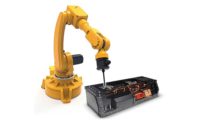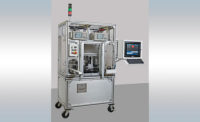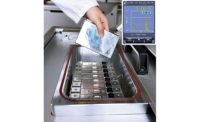Sales of electric vehicles (EVs)—particularly plug-in hybrids and full battery electrics—are growing faster than expected, according to a study released earlier this year by the Boston Consulting Group.
EVs currently represent about 8 percent of global vehicle sales, but they will account for a third of sales by 2025, according to the report. Moreover, EV sales could even surpass sales of gas-powered vehicles by 2030, taking 51 percent of the market.
Already, established and startup automakers expect to introduce more than 100 electric vehicle models over the next three years. Automakers have committed $300 billion to EV development, and they continue to invest in vehicle charging infrastructure.
For EVs to surpass gas-powered cars, however, OEMs will need to assuage consumer concerns over quality, durability and safety, particularly for the primary component of EVs: the battery pack. For starters, the pack—and all the individual cells that make up the pack—must be absolutely leakproof. The electrolyte solution must not leak out of the cell, and moisture must not leak into it. That’s no small thing, considering that an EV contains hundreds or even thousands of battery cells.
“To guarantee a long lifetime for the battery, it’s really important that no contaminants reach the solvents and the lithium ion salts inside the batteries,” says Daniel Wetzig, Ph.D., research manager for Inficon.
Failure to detect such leaks can be costly. In June 2019, for example, Audi voluntary recalled 1,644 E-Tron electric SUVs worldwide because of a risk that moisture could seep into the battery cells through the wiring harness. That same month, Chinese EV startup NIO recalled nearly 5,000 of its ES8 electric SUVs after multiple reports of battery fires.
Now, a new technology from Inficon, the ELT3000, will enable automakers and battery suppliers to leak-test fully assembled EV battery cells more accurately and reliably.
Hard and Soft
Three types of battery cells are used to power electric and hybrid-electric vehicles: hard-cased prismatic and cylindrical cells and soft lithium-polymer, or pouch, cells.
Hard-cased cells are currently leak-tested with a helium-based method. The empty cell is placed inside a vacuum chamber and pressurized with helium. After air is evacuated from the chamber, a mass spectrometer samples the inside of the chamber. If it detects helium, the cell has a leak. If the cell passes, it is filled with an electrolyte solution, and a cap is laser-welded on to seal the assembly.
The problem with that method is that it doesn’t check the weld seam.
“Historically, a tracer gas has been used to leak-test rigid cells, and the battery manufacturer would just hope that the laser weld was perfect,” explains Thomas Parker, automotive leak testing sales manager for Inficon. “It’s also possible that a leak can develop later, after further handling. When these cells are made, they are charged and discharged. Sometimes, all that handling after assembly can open up a small leak that the helium leak test might have missed.”
Ideally, then, batteries should be checked for leaks after final assembly and electrical testing. One way to do that is by “helium bombing.” With this method, a batch of assemblies is placed in a chamber and exposed to helium at a set pressure for a set length of time. If an assembly has a leak, helium will gradually seep into it. Next, the assemblies are removed from the helium chamber and placed, one at a time, in a second chamber and a vacuum is drawn. A mass spectrometer then looks for helium leaking from the assembly.
This is how air bag igniters are tested. However, this technique is typically not suited for liquid-filled components. “You can’t get the gas inside,” Wetzig points out.
Pouch cells don’t have a rigid metal case, which makes them lightweight and compact. The pouches resemble packages of vacuum-packed coffee—only longer, wider and thinner. The design is not amenable to conventional vacuum-based leak-testing methods, because the pouch itself holds a vacuum.
“You have vacuum conditions inside the pouch cell and that makes it more complicated to test,” says Wetzig. “You need vacuum outside of the cell to force [molecules] from inside the product to the outside [where they can be detected.]”
Pressure-based leak-testing methods are also problematic. “You could put the cell in a pressure vessel, apply pressure, and if the pressure changes by a certain amount in a certain amount of time, you can assume that pressure has gone inside the part, and you have a leak,” explains Parker. “Another approach is simply to let these pouches sit for hours or even days. Then, technicians will check the cells to see if they’ve expanded. It’s a visual inspection.
“Neither method can find a hole that could allow humidity to penetrate the cell.”
A Different Approach
Inficon’s new system will, for the first time, enable automakers and battery suppliers to accurately test battery cells that have already been filled with electrolyte and welded shut. The instrument can identify leaks 1,000 times smaller than what can currently be detected with existing technologies. The system consists of a mass spectrometer, a vacuum control unit, and a vacuum chamber. Equipment for testing prismatic and cylindrical cells is scheduled for introduction in October, while instruments for testing pouch cells will be available in late 2020 or early 2021.
As with tracer gas methods, Inficon’s process begins with placing the battery cells in the chamber and pulling a vacuum. However, instead of trying to detect a tracer gas, like helium, Inficon’s technology is designed to detect molecules from common electrolyte solvents used in batteries, including dimethyl carbonate (DMC), diethyl carbonate (DEC) and ethyl methyl carbonate (EMC). The system can detect leak paths as small as approximately 2 microns, equivalent to the smallest detectable helium leak rate of 1 x10-6 millibar-liter per second.
“We took established technology that we developed to detect refrigerants in the air conditioning and refrigeration industry, and we applied it to detect electrolytes coming from the battery cell,” says Parker. “It took us two to three years to figure out the best way to detect the electrolytes.
“We also had to figure out the best way to fabricate calibrated leaks for metrology purposes. Because of the viscosity of the electrolyte, it’s hard to make a repeatable, calibrated leak. Our customers are focused on metrology and measurement certainty. Whether you’re making an air bag inflator, a pacemaker or a battery pack, you have to prove that your process is capable.”
Another innovation is Inficon’s flexible, saucer-shaped vacuum chamber for testing pouch cells. The chamber is based on the company’s Contura S400 system for leak-testing flexible food packages. It features a pair of flexible membranes that conform to the cell without blocking potential leak paths.
“If you put a pouch cell inside a rigid vacuum chamber, the pouch will expand under vacuum,” explains Wetzig. “With a flexible chamber, you can generate vacuum conditions directly around the pouch, but at the same time, atmospheric pressure still acts on the pouch. A small gap is maintained between the pouch and the chamber, and that volume is [enough to allow molecules] to leak from the test object.”
Depending on the size and type of the cell, the ELT3000 system can test more than one battery cell at once. Test time is 45 to 60 seconds per batch, depending on the size of the vacuum chamber.
Although the system was originally conceived for testing EV batteries, it could also be used to leak-test batteries for consumer electronics, computers, medical devices, power tools and other applications.







